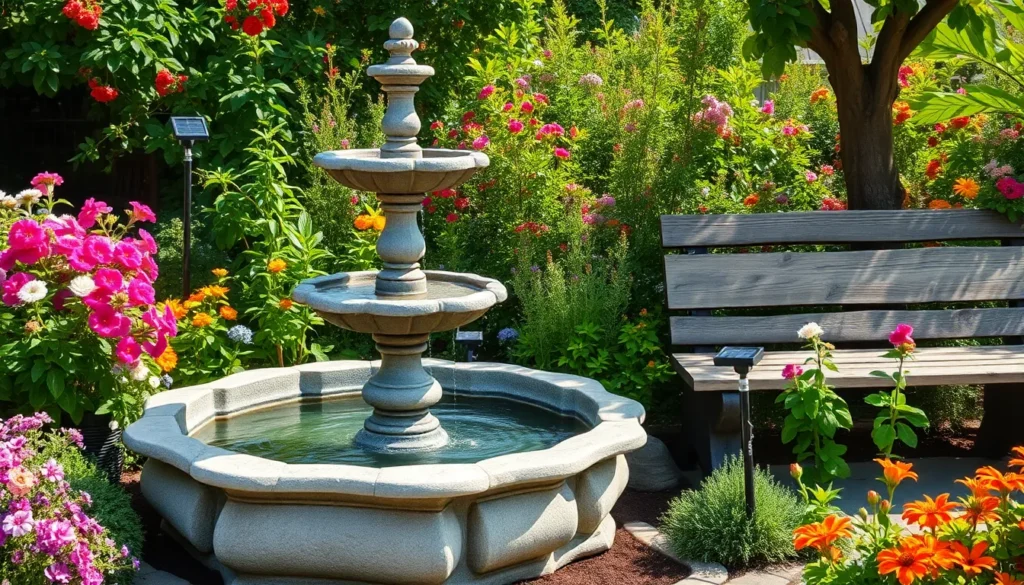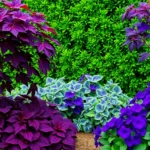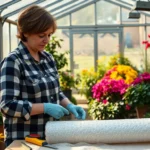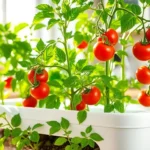We’ve all walked through stunning gardens and wondered what makes certain spaces feel so captivating and complete. The secret often lies in one key element: a thoughtfully chosen centerpiece that draws the eye and anchors the entire industry design.
Garden centerpieces transform ordinary outdoor spaces into extraordinary retreats that reflect your personal style while creating natural gathering points for family and friends. Whether you’re working with a sprawling backyard or a cozy patio garden these focal points can dramatically elevate your industry’s visual appeal and functionality.
From elegant water features and sculptural plants to rustic fire pits and artistic installations we’ll explore creative centerpiece ideas that work with any budget and garden size. You’ll discover how the right focal point can solve common design challenges while creating that picture-perfect outdoor sanctuary you’ve been dreaming of.
Create a Stunning Water Feature as Your Garden’s Focal Point
Water features transform ordinary gardens into captivating outdoor sanctuaries that naturally draw the eye and create peaceful atmospheres. Adding moving water to your garden centerpiece brings both visual appeal and soothing sounds that enhance the overall ambiance.
Install a Classic Three-Tier Fountain
Installing a three-tier fountain creates an elegant focal point that works beautifully in traditional and formal garden settings. We recommend choosing fountains made from durable materials like cast stone, ceramic, or weather-resistant resin that can withstand seasonal changes.
Position your fountain at the intersection of main pathways to maximize its visual impact throughout your garden space. Most three-tier fountains require a 6-foot diameter clearance area and need access to electrical outlets for pump operation.
Surrounding plantings like boxwood hedges, ornamental grasses such as fountain grass, or colorful annuals like petunias create stunning backdrops that complement the fountain’s cascading water. Proper lighting installation allows you to enjoy your fountain’s beauty during evening hours and creates magical reflections on surrounding surfaces.
Design a Modern Reflecting Pool
Designing a reflecting pool offers a contemporary approach to water features that emphasizes clean lines and minimalist aesthetics. We suggest rectangular or circular shapes with depths between 18 to 24 inches for optimal reflection quality without excessive maintenance requirements.
Modern reflecting pools work exceptionally well when constructed with materials like polished concrete, natural stone slabs, or sleek metal edging that matches your home’s architectural style. Incorporate underwater LED lighting systems to create dramatic evening displays that highlight both the water surface and surrounding industry elements.
Strategic placement near architectural features like pergolas, modern sculptures, or geometric planters enhances the pool’s contemporary appeal. Consider adding water lilies, lotus plants, or floating gardens to introduce natural elements while maintaining the pool’s sophisticated appearance.
Build a Natural Stone Waterfall
Building a natural stone waterfall creates an impressive garden centerpiece that mimics organic water features found in nature. We recommend using locally sourced stones like limestone, slate, or river rock to ensure your waterfall blends seamlessly with your regional industry.
Plan for a water circulation system that includes a hidden reservoir, submersible pump, and flexible tubing to create continuous water flow. Most DIY waterfall projects require excavation depths of 2 to 3 feet and stone arrangements that allow water to cascade naturally from level to level.
Incorporate native plants like ferns, hostas, or moss around your waterfall to enhance its natural appearance and provide habitat for beneficial wildlife. Adding stepping stones, wooden bridges, or meandering pathways near your waterfall creates opportunities for close-up enjoyment and photography.
Design an Eye-Catching Sculpture Garden Display
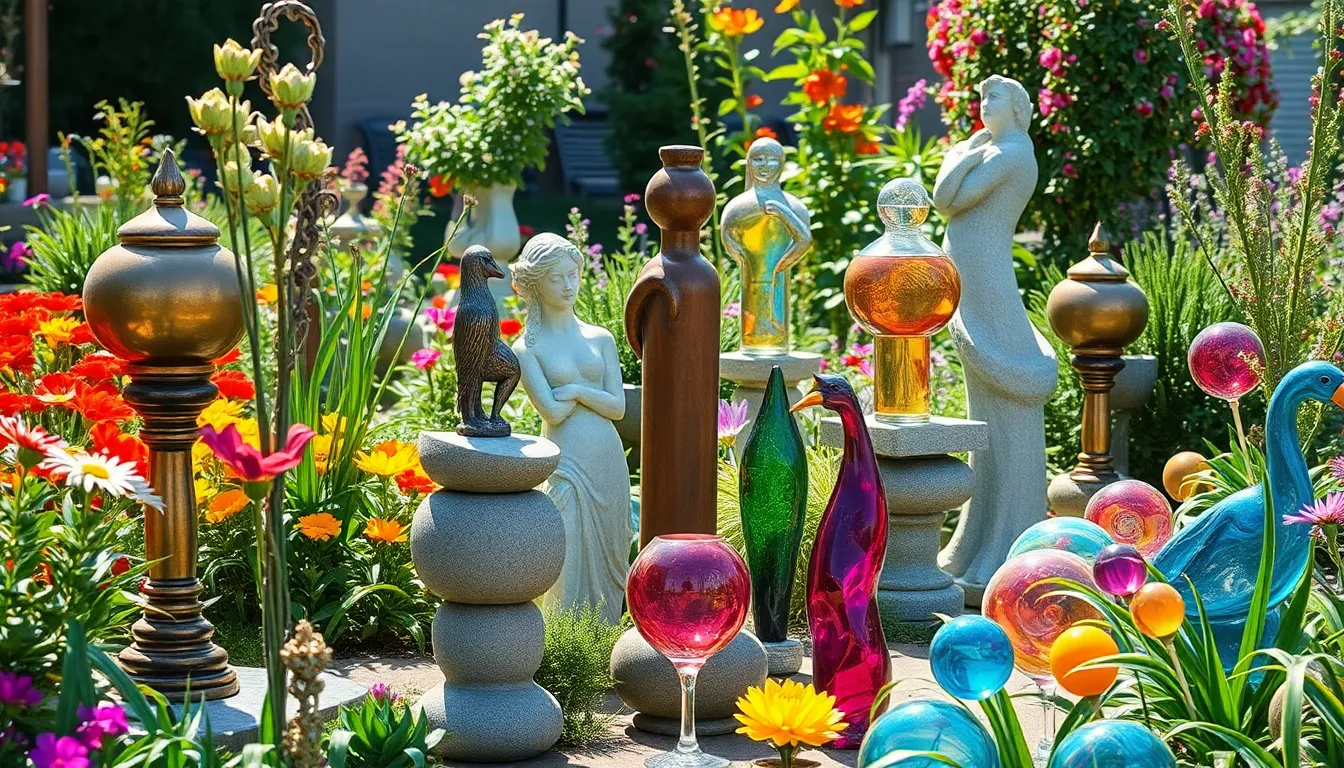
Sculptures bring artistic sophistication to your garden centerpiece while creating lasting visual interest throughout the seasons. Let’s explore how strategic art placement can transform your outdoor space into a captivating gallery.
Choose Weather-Resistant Metal Art Pieces
Select stainless steel or bronze sculptures that withstand outdoor conditions while maintaining their visual appeal over time. These durable materials resist rust, corrosion, and weather damage, ensuring your investment remains beautiful for years. Consider abstract geometric forms, wildlife sculptures, or contemporary art pieces that complement your garden’s style.
Position metal sculptures on stable stone or concrete pedestals to prevent tipping during storms. We recommend choosing pieces with smooth finishes that reflect light beautifully during different times of day. Large metal sculptures work best as primary focal points, while smaller pieces can accent pathways or garden borders.
Maintenance becomes minimal with quality metal art pieces, requiring only occasional cleaning with mild soap and water. Bronze sculptures develop an attractive patina over time, adding character and depth to their appearance.
Incorporate Handcrafted Stone Sculptures
Handcrafted stone sculptures add unique character and timeless elegance to your garden centerpiece display. Natural stone materials like granite, marble, and sandstone blend seamlessly with industry elements while providing exceptional durability. These sculptures can include figurines, abstract designs, or natural stone arrangements that reflect your personal taste.
Consider commissioning local artisans to create custom pieces that perfectly match your garden’s theme and scale. Stone sculptures work particularly well near water features, where their natural textures complement the organic flow of fountains or pools. We suggest grouping different sized stone pieces to create ever-changing visual compositions.
Weather naturally enhances stone sculptures, allowing moss and lichen to develop attractive patinas that increase their garden integration over time. Position these pieces where they’ll receive varying light throughout the day to showcase their textural details and shadows.
Display Colorful Glass Garden Art
Colorful glass sculptures and ornaments inject vibrant hues into your garden centerpiece while creating stunning light effects. These pieces can be suspended from trees, mounted on posts, or placed strategically among plants for dramatic color pops. Glass art catches and reflects sunlight, creating rainbow prisms and sparkling highlights throughout your garden.
Choose tempered or safety glass pieces designed specifically for outdoor use to ensure durability against weather extremes. We recommend selecting colors that complement your existing flower palette while providing contrast during different blooming seasons. Blue and green glass pieces work beautifully near water features, while warm oranges and reds enhance autumn garden displays.
Install proper lighting near glass art pieces to extend their visual impact into evening hours. Solar-powered spotlights or LED strips can illuminate glass sculptures from below, creating magical glowing effects that transform your garden after dark.
Plant a Show-Stopping Flower Bed Arrangement
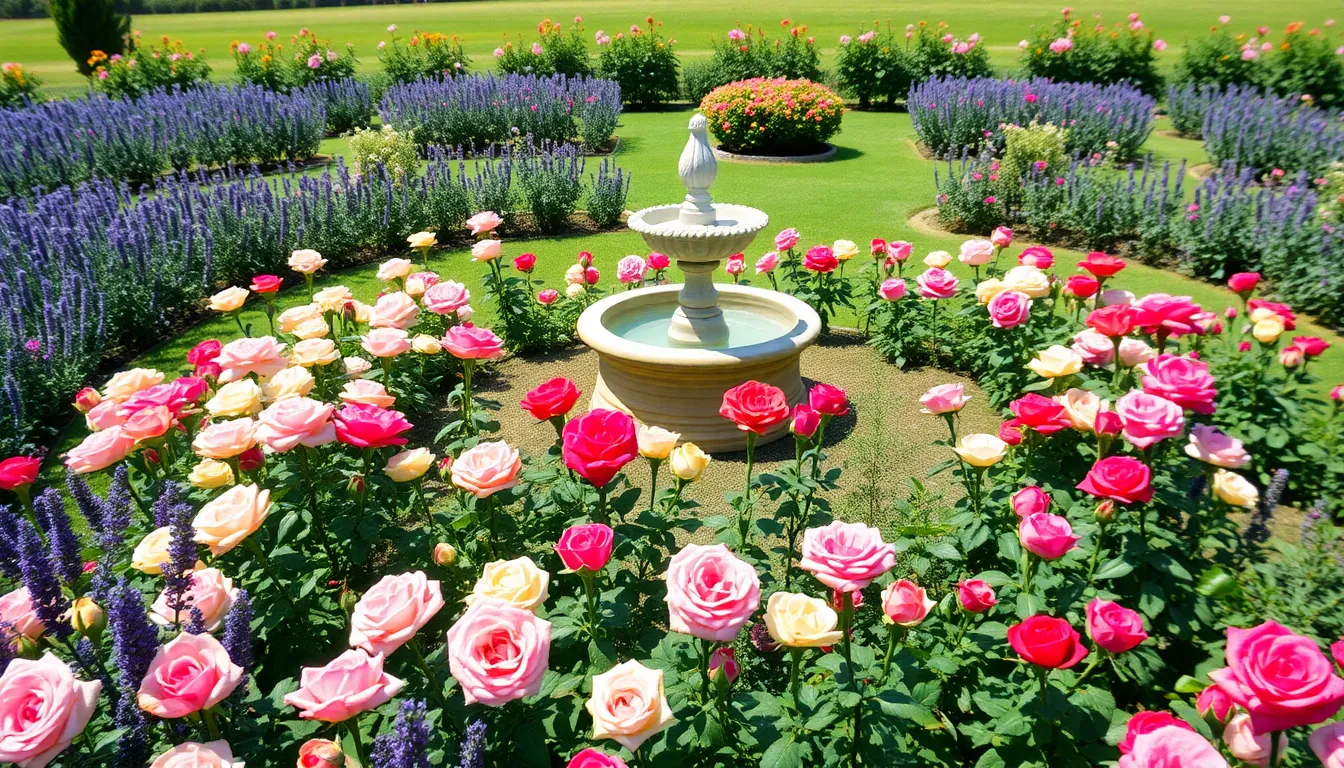
Flower bed arrangements serve as ever-changing living centerpieces that evolve throughout the seasons, offering continuous visual interest and fragrance. We can transform any garden space into a captivating focal point by combining strategic plant placement with thoughtful design principles.
Create a Circular Rose Garden Design
Circular rose gardens establish romantic focal points that command attention from every angle in your outdoor space. We recommend planning a design with a central element like a decorative fountain or elegant statue surrounded by concentric rings of different rose varieties.
Choose complementary rose types including hybrid teas, floribundas, and climbing roses to create varied heights and textures throughout your circular design. Position taller varieties toward the center and gradually decrease height as you move outward to maintain visual balance.
Select roses with staggered bloom times such as early blooming David Austin roses, mid season hybrid teas like ‘Mr. Lincoln’, and late flowering varieties including ‘Knockout’ roses. This approach ensures continuous color from spring through fall while creating ever-changing seasonal transitions.
Install proper spacing between plants with 3 to 4 feet between each rose bush to allow adequate air circulation and prevent disease issues[5]. Add complementary plantings like lavender, catmint, or boxwood hedging around the perimeter to frame your rose centerpiece beautifully.
Develop a Cottage Garden Wildflower Mix
Cottage garden wildflower arrangements capture the charm of traditional English gardens while supporting local wildlife and pollinators. We suggest combining native wildflowers with herbs and cottage garden staples for an authentic, carefree appearance.
Plant height variations using tall sunflowers, medium height black eyed susans, and low growing daisies to create natural looking layers[6]. Mix these flowering plants randomly rather than in structured patterns to achieve that authentic cottage garden aesthetic.
Include aromatic herbs such as rosemary, thyme, and lavender between your wildflower plantings to add fragrant elements and practical harvesting opportunities. These herbs also help repel pests naturally while attracting beneficial insects to your garden centerpiece.
Add shrubs for structure including native species like elderberry, serviceberry, or flowering dogwood to provide year round interest and habitat for birds[6]. Position these larger plants strategically to create natural boundaries and backdrop elements for your wildflower display.
Establish a Formal Geometric Planting Pattern
Formal geometric patterns create sophisticated centerpieces that showcase precision and classic garden design principles. We can achieve stunning results using structured plantings, topiary elements, and carefully planned color schemes.
Design with geometric shapes including triangles, squares, or diamond patterns using low hedging plants like boxwood or dwarf barberry. Create these defined borders first, then fill interior spaces with seasonal plantings that complement your chosen geometric form.
Use contrasting colors and textures by pairing plants with different foliage characteristics such as silvery artemisia against deep green boxwood, or burgundy coleus alongside bright green hostas[7]. These contrasts emphasize your geometric design while adding visual depth.
Incorporate topiary elements as focal points within each geometric section using plants like privet, yew, or holly shaped into spheres, cones, or spirals. Position these sculptural plants at intersection points or corners to reinforce your formal design structure while creating multiple points of interest.
Build a Functional Fire Feature for Year-Round Appeal
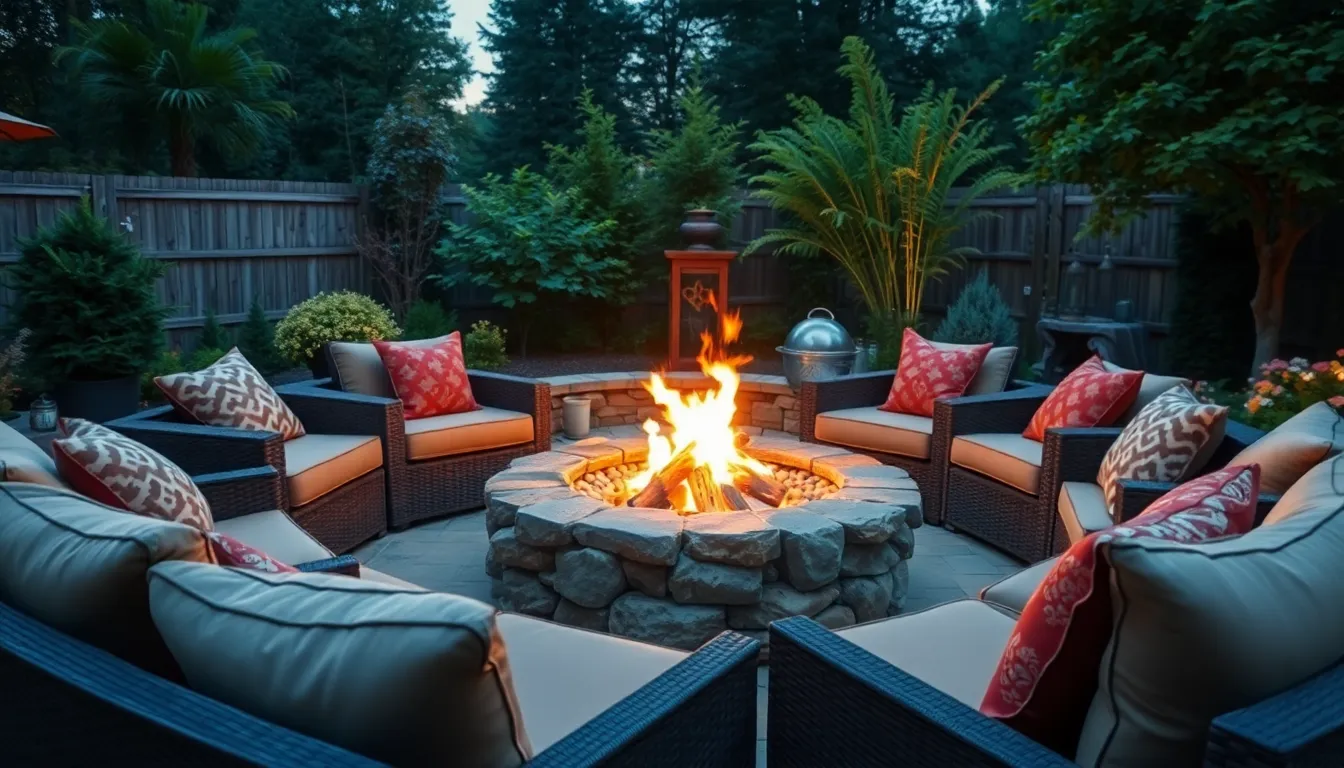
Fire features create warmth and ambiance that extends garden enjoyment beyond summer months. We’ll explore three distinct fire centerpiece options that serve as gathering points while adding architectural interest to your outdoor space.
Construct a Stone Fire Pit Gathering Area
Building a stone fire pit transforms your garden into a communal gathering space perfect for year-round entertainment. Natural stone materials like fieldstone or flagstone create a rustic aesthetic that complements surrounding plantings while providing excellent heat retention.
Start by selecting a level area at least 20 feet away from structures and overhanging branches. Excavate a circular area 6 feet in diameter and 6 inches deep to accommodate the fire ring and surrounding stone border. Install a metal fire ring insert to contain flames safely while protecting the stone construction from extreme heat damage.
Arrange larger stones as the base layer, followed by progressively smaller stones to create seating walls around the perimeter. We recommend incorporating comfortable cushions or weather-resistant pillows to enhance seating comfort during extended gatherings. Add gravel pathways leading to the fire pit area to improve accessibility and define the space within your garden design.
Install a Sleek Outdoor Fireplace
Outdoor fireplaces provide sophisticated warmth while serving as striking architectural focal points that anchor garden design. Modern designs feature clean lines and materials like stainless steel, concrete, or natural stone that complement contemporary outdoor living spaces.
Choose between prefabricated units or custom-built installations based on your budget and design preferences. Prefabricated models offer easier installation and typically cost between $1,500 to $5,000, while custom designs range from $5,000 to $15,000 depending on materials and complexity.
Position the fireplace to maximize wind protection and create intimate seating arrangements nearby. Install proper ventilation systems and gas lines if opting for gas-powered units, which provide convenient ignition and consistent heat output. Surround the fireplace with comfortable outdoor furniture and add ambient lighting to create a resort-like atmosphere in your garden retreat.
Design a Portable Fire Bowl Setup
Portable fire bowls offer flexibility and convenience for gardens where permanent installations aren’t feasible. These versatile centerpieces can be relocated seasonally or stored during harsh weather conditions while still providing the warmth and ambiance of traditional fire features.
Select fire bowls made from durable materials like cast iron, steel, or ceramic that withstand temperature fluctuations and outdoor exposure. Sizes range from compact 24-inch diameter bowls suitable for intimate gatherings to larger 36-inch models that accommodate bigger groups.
Create a dedicated area using fire-resistant materials like gravel, sand, or concrete pavers to protect surrounding grass and plantings. Position the fire bowl on stable, level ground and maintain proper clearance from combustible materials. We suggest adding decorative elements like river rocks or lava stones around the base to integrate the feature seamlessly with your garden’s aesthetic while providing additional safety barriers.
Establish a Charming Seating Area Centerpiece
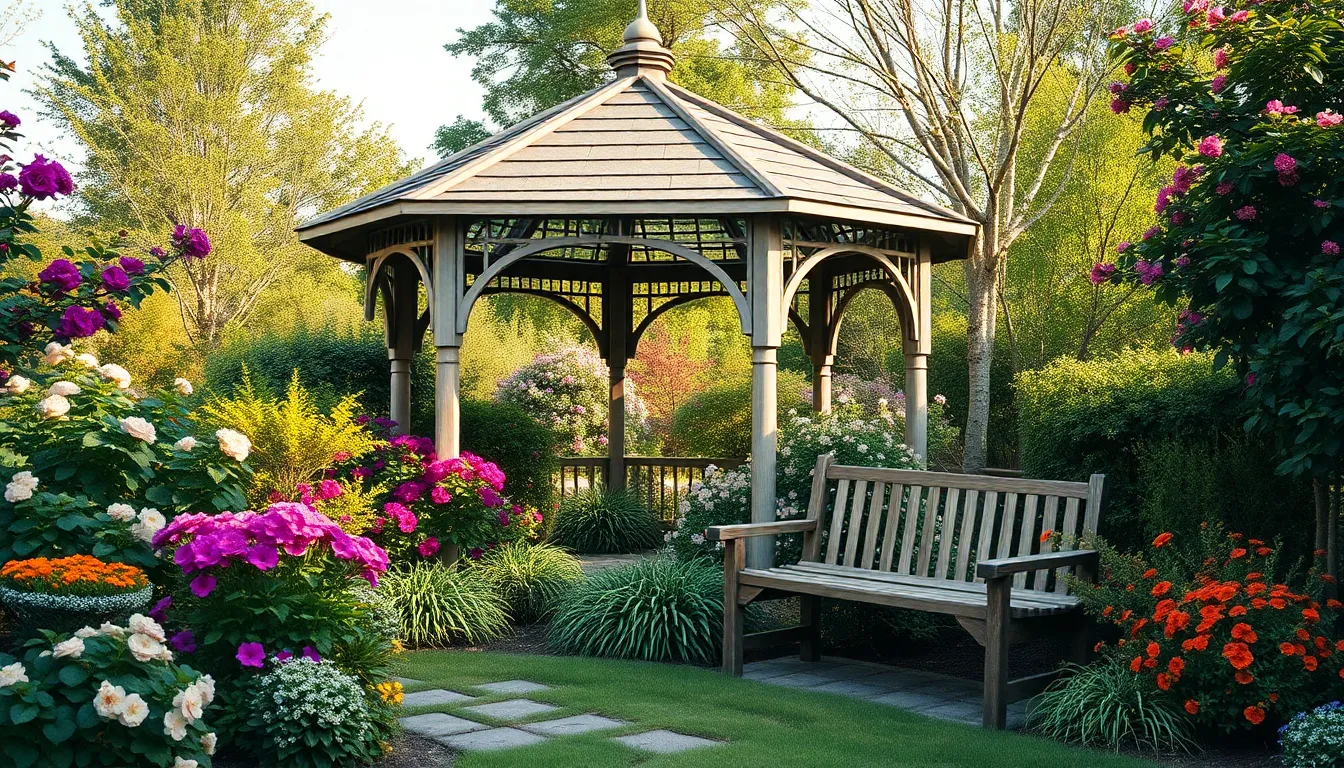
Creating a dedicated seating area centerpiece transforms your garden into an inviting retreat where relaxation meets natural beauty. These focal points provide both functional gathering spaces and stunning visual anchors that draw the eye throughout your outdoor sanctuary.
Create a Pergola with Climbing Vines
Pergolas with lush climbing vines offer vertical drama while creating intimate outdoor rooms beneath their canopy. We recommend selecting vigorous vines like wisteria, clematis, or honeysuckle that’ll develop into a living ceiling over time.
Structure considerations ensure your pergola can support mature vine growth. Install sturdy posts using cedar or pressure-treated lumber that can handle the weight of established climbing plants. Space vertical supports approximately 8-10 feet apart for optimal stability.
Vine selection determines both the visual impact and maintenance requirements of your centerpiece. Wisteria creates spectacular spring blooms but requires annual pruning to prevent overwhelming growth. Clematis varieties provide continuous color from spring through fall with less aggressive spreading habits.
Seasonal planning maximizes year-round appeal by combining multiple vine species. Plant evergreen clematis alongside deciduous varieties to maintain winter interest while ensuring abundant summer coverage.
Build a Classic Garden Gazebo
Garden gazebos serve as elegant architectural centerpieces that provide shelter and sophisticated focal points. We suggest choosing designs that complement your home’s architectural style while creating a natural gathering space for outdoor entertaining.
Design harmony connects your gazebo to the surrounding industry through material selection and proportional sizing. Traditional Victorian styles work beautifully with cottage gardens, while clean-lined contemporary gazebos complement modern industry designs.
Surrounding integration requires thoughtful plantings that frame the structure without overwhelming its presence. Plant foundation shrubs like hydrangeas or roses around the gazebo’s perimeter, leaving adequate space for maintenance access.
Interior furnishing transforms your gazebo into a functional outdoor room. Add weather-resistant seating, outdoor lighting, and seasonal decorations that invite relaxation and social gatherings throughout the growing season.
Design a Rustic Wooden Bench Arrangement
Rustic wooden bench arrangements create cozy centerpieces that emphasize natural materials and informal garden charm. We position these benches in quiet garden corners surrounded by lush plantings that encourage contemplation and peaceful moments.
Bench placement maximizes views while providing comfortable seating in partially shaded locations. Select spots that offer morning sun exposure but afternoon shade, creating comfortable conditions during peak garden enjoyment hours.
Surrounding plantings enhance the rustic aesthetic through carefully chosen perennials and seasonal displays. Place large planters filled with colorful flowers like impatiens, begonias, or seasonal annuals around the bench to create visual weight and interest.
Seasonal decorations keep the arrangement fresh throughout the year. Switch out planter contents with spring bulbs, summer flowers, autumn mums, and winter evergreen boughs to maintain year-round appeal and seasonal relevance.
Install a Dramatic Lighting Display
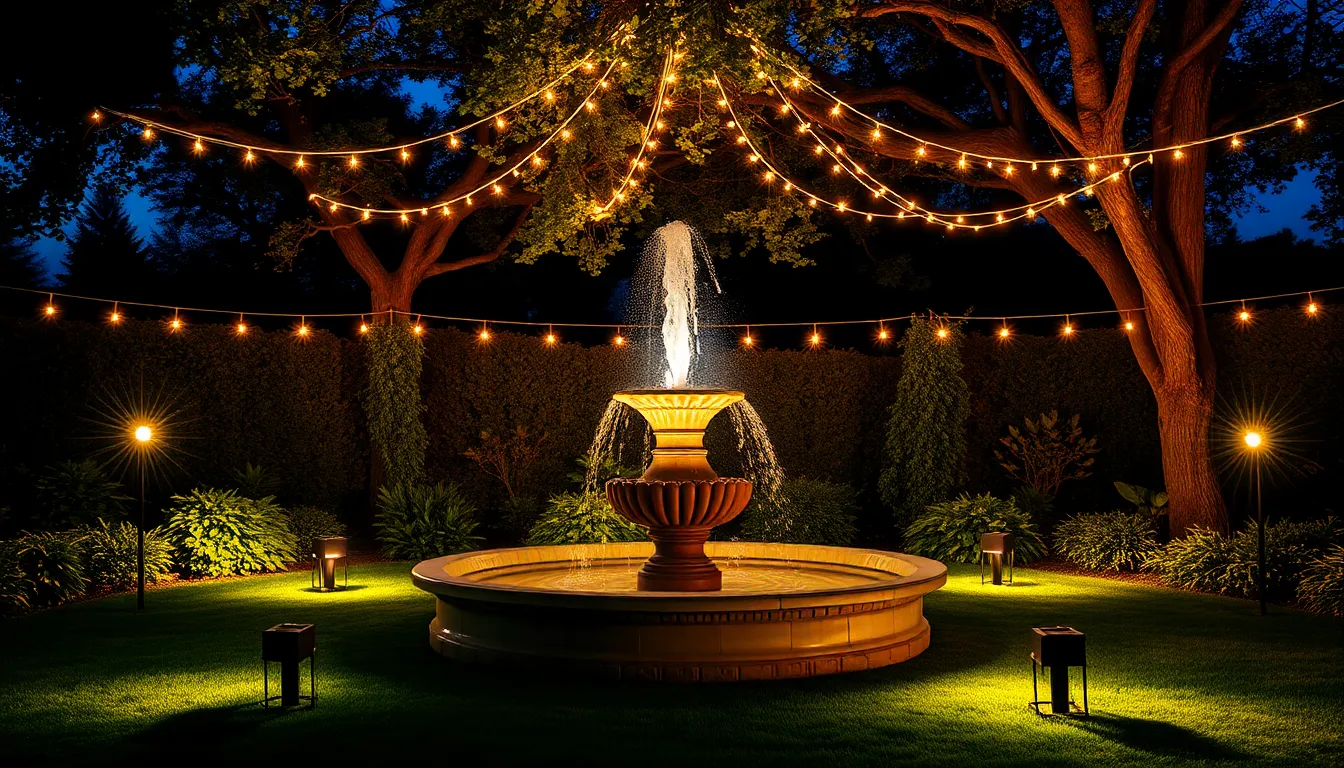
Transforming your garden centerpiece into a captivating nighttime focal point requires strategic lighting that enhances both beauty and functionality. Proper illumination extends your outdoor enjoyment well into the evening hours while creating stunning visual effects that showcase your garden’s best features.
Set Up Solar-Powered Garden Spotlights
Solar-powered spotlights offer an eco-friendly and cost-effective solution for highlighting your garden centerpiece without increasing electricity bills. Position these lights at ground level, angling them upward to create dramatic shadows and depth around fountains, sculptures, or architectural features. We recommend selecting spotlights with adjustable heads that deliver at least 200 lumens for adequate brightness and visibility.
Installing solar spotlights requires no electrical wiring, making them perfect for remote garden areas or rental properties where permanent fixtures aren’t feasible. Place units in areas that receive 6-8 hours of direct sunlight daily to ensure optimal battery performance throughout the night. Modern solar spotlights feature automatic dusk-to-dawn sensors that activate lighting precisely when needed, providing up to 10 hours of continuous illumination on a full charge.
Create String Light Canopy Effects
String lights suspended overhead create magical ambiance that transforms any garden centerpiece into an enchanting evening destination. Drape warm white LED string lights between pergola posts, tree branches, or specially installed anchor points to form a glowing canopy above seating areas or water features. We suggest using weatherproof string lights with spacing between 6-12 inches for optimal light distribution.
Creating successful canopy effects requires planning the installation height between 8-10 feet to allow comfortable movement underneath while maintaining intimate atmosphere. Commercial-grade string lights with heavy-duty cord construction withstand outdoor conditions better than residential versions, lasting 3-5 years with proper care. Consider dimmer controls or smart switches that allow you to adjust brightness levels for different occasions and moods.
Design LED Pathway Illumination
LED pathway lighting guides visitors through your garden while drawing attention to your centerpiece through carefully planned routing and visual flow. Install low-voltage LED fixtures every 6-8 feet along curved pathways that lead naturally toward your focal point, creating anticipation and discovery. We recommend selecting fixtures that cast downward light to minimize glare while providing adequate safety illumination for nighttime navigation.
Designing effective pathway illumination involves varying light heights and intensities to create visual interest without overwhelming the space. Ground-level recessed lights work beautifully for formal gardens, while stake-mounted fixtures complement naturalistic designs with flexible placement options. LED technology consumes 75% less energy than traditional bulbs while lasting 25 times longer, making them ideal for continuous outdoor use with minimal maintenance requirements.
Develop a Themed Garden Room Concept
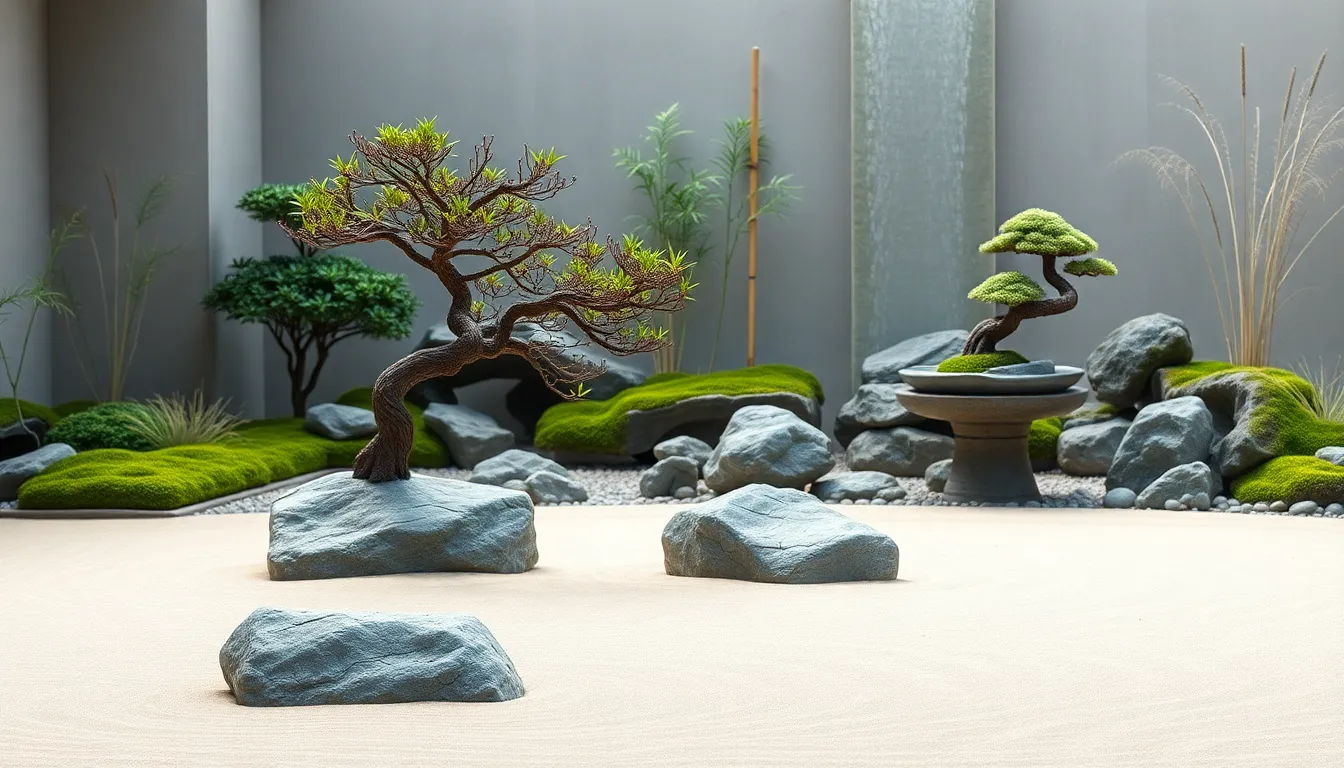
Themed garden rooms create distinct outdoor spaces that transport visitors to different cultural landscapes and design philosophies. We’ll explore three captivating themed concepts that transform ordinary gardens into extraordinary experiences.
Create a Japanese Zen Garden Space
Rocks and sand form the foundation of an authentic Japanese Zen garden centerpiece. Strategically placed stones within a carefully raked sand garden create peaceful meditation zones that encourage mindfulness and reflection. Large granite or river rocks serve as focal points while smaller stones create visual balance throughout the space.
Bonsai trees anchor the serene atmosphere with their sculptural beauty and symbolic meaning. We recommend choosing hardy varieties like juniper or pine that withstand outdoor conditions year round. Position your bonsai on a weathered wooden stand or natural stone pedestal to elevate its presence and create visual hierarchy.
Bamboo water features add gentle sounds that enhance the meditative quality of your Zen space. Simple bamboo fountains or deer scarers (shishi-odoshi) create rhythmic water sounds without overwhelming the peaceful ambiance. Surround these elements with moss covered stones and minimal plantings of ornamental grasses like mondo grass or Japanese forest grass.
Design a Mediterranean Herb Garden
Herb planters filled with aromatic Mediterranean plants create both beautiful and functional centerpieces. Large terracotta containers overflowing with rosemary, thyme, oregano, and lavender establish the authentic Mediterranean feel while providing fresh herbs for cooking. Group planters of varying heights to create visual interest and ensure proper drainage for each herb variety.
Olive trees serve as stunning focal points that instantly evoke Mediterranean landscapes. We suggest choosing dwarf varieties like Arbequina or Picual that thrive in containers and produce actual olives. Place your olive tree in a substantial ceramic or stone planter surrounded by drought tolerant herbs and succulents.
Natural stone pathways and walls complete the Mediterranean aesthetic while providing structure to your herb garden. Use limestone, travertine, or local stone to create raised beds and seating areas. Incorporate gravel mulch around plantings to suppress weeds and retain moisture while maintaining the authentic Mediterranean appearance.
Establish an English Cottage Garden Corner
Floral arrangements featuring English roses create the quintessential cottage garden centerpiece. Dense plantings of David Austin roses like ‘Graham Thomas’ and ‘Gertrude Jekyll’ provide continuous blooms and intense fragrance throughout the growing season. Layer these roses with complementary perennials such as delphiniums, foxgloves, and hollyhocks for vertical interest and cottage garden authenticity.
Vintage garden benches positioned among lush plantings invite contemplation and create cozy gathering spots. We recommend weathered teak or painted wooden benches that develop character over time. Surround your seating with fragrant herbs like lavender and catmint that release pleasant scents when brushed against.
Picket fencing and arbors add architectural elements that define your cottage garden space. White painted picket fences create boundaries while climbing roses and clematis on wooden arbors provide vertical growing space. Include traditional cottage garden plants like sweet peas, morning glories, and honeysuckle that scramble over these structures for authentic English countryside charm.
Incorporate Seasonal Decorative Elements
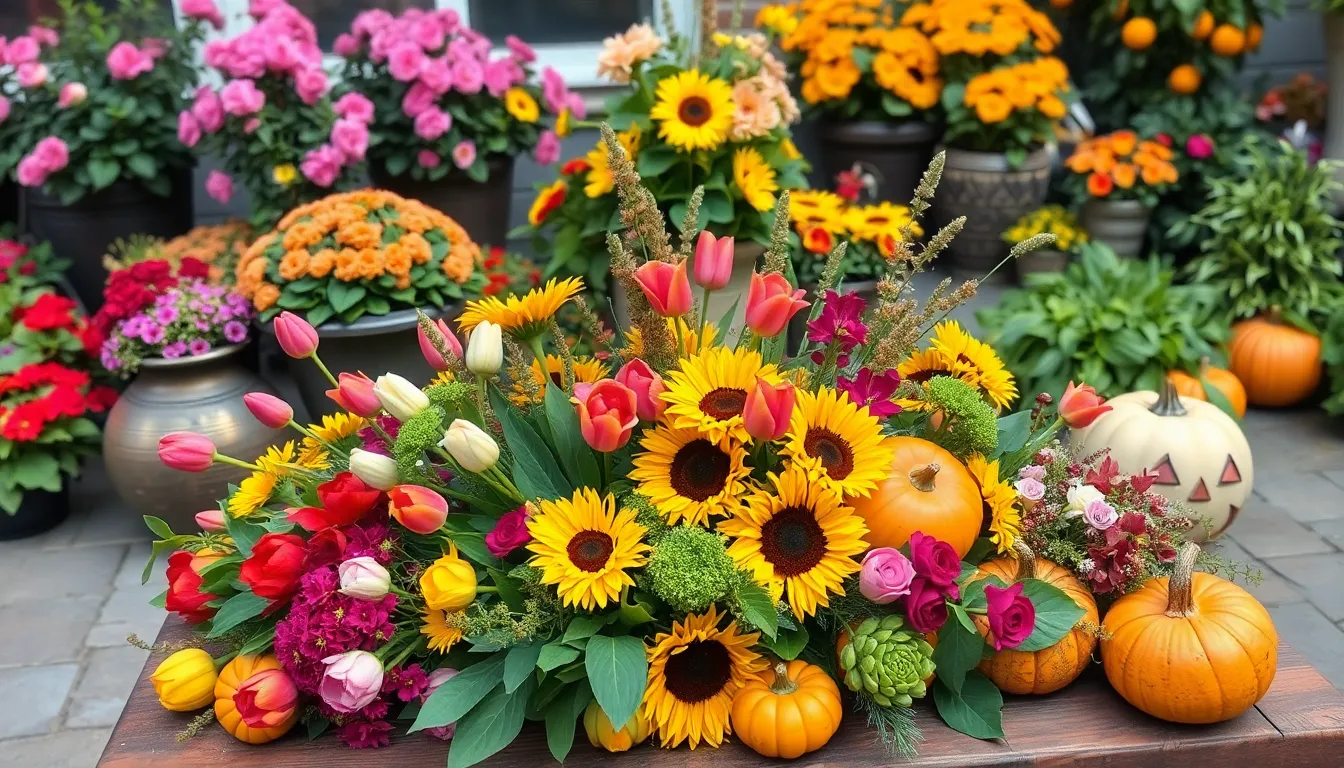
Transforming your garden centerpiece with seasonal elements keeps your outdoor space fresh and captivating throughout the year. We’ll explore ever-changing approaches that celebrate each season’s unique beauty while maintaining visual interest.
Design Rotating Seasonal Plant Displays
Spring arrangements showcase tulips and daffodils as vibrant focal points that herald the arrival of warmer weather. These early bloomers create stunning centerpieces when paired with fresh greenery and emerging perennial shoots.
Summer displays feature robust plants like sunflowers and zinnias that thrive in warm temperatures and provide bold color statements. We recommend incorporating lush greenery to create depth and texture around your primary flowering elements.
Fall transitions bring opportunities to feature chrysanthemums alongside decorative pumpkins and colorful autumn foliage. These arrangements capture the season’s warmth with rich oranges, deep reds, and golden yellows that complement the changing industry.
Winter displays use evergreen branches, pinecones, and winter berries to maintain visual appeal during dormant months. Herbs like rosemary and thyme work exceptionally well in garlands or decorative pots, providing both fragrance and culinary value throughout colder seasons.
Create Holiday-Themed Garden Decorations
Christmas centerpieces incorporate holly, mistletoe, and evergreen branches to create festive arrangements that welcome the holiday season. These natural elements provide traditional charm while withstanding winter weather conditions.
Thanksgiving displays feature pumpkins, corn husks, and fall leaves that celebrate the harvest season’s abundance. We suggest arranging these elements in tiered displays to create visual depth and seasonal authenticity.
Easter decorations add pastel-colored flowers alongside spring greenery and decorative eggs for cheerful seasonal appeal. These lighter color palettes reflect spring’s renewal and create uplifting focal points as gardens emerge from winter dormancy.
Valentine’s Day arrangements can feature red roses, pink tulips, and heart-shaped topiary forms for romantic garden centerpieces. These seasonal touches create intimate outdoor spaces perfect for special celebrations.
Establish Four-Season Interest Plantings
Year-round plantings combine evergreen shrubs with flowering perennials and seasonal bulbs to maintain continuous visual appeal. This strategic approach ensures your centerpiece remains attractive regardless of seasonal changes.
Structural plants like boxwood and ornamental grasses provide consistent form throughout all seasons. We recommend using these as anchor elements that support rotating seasonal additions without compromising the overall design integrity.
Bulb succession planting creates seamless transitions from spring crocuses to summer lilies to fall-blooming colchicum. This technique extends flowering periods and maintains color interest across multiple seasons.
Seasonal rotation schedules help maintain fresh appearances by replacing spent plants with new seasonal varieties. Cacti and succulents work particularly well for fall and winter displays, requiring minimal maintenance while providing interesting textures and forms.
Conclusion
Creating the perfect garden centerpiece doesn’t have to be overwhelming when you have the right inspiration and guidance. We’ve explored many options that can transform any outdoor space into a captivating retreat.
Whether you’re drawn to the tranquil sounds of water features or the dramatic appeal of sculptural elements your choice should reflect your personal style and garden’s unique character. Remember that the most successful centerpieces often combine multiple elements – perhaps pairing a stunning fire feature with strategic lighting or complementing a themed garden room with seasonal decorations.
The key is starting with one focal point that resonates with you and building from there. Your garden centerpiece will become the heart of your outdoor sanctuary bringing joy beauty and functionality to your space for years to come.
Frequently Asked Questions
What makes a good centerpiece for a garden?
A good garden centerpiece should serve as a focal point that draws attention and enhances the overall design. It can be a water feature, sculpture, fire pit, or unique planting arrangement. The key is choosing something that complements your garden’s style, fits your space and budget, and creates visual interest while addressing design challenges.
How do I choose between different types of water features for my garden?
Consider your garden’s size, style, and maintenance preferences. Classic three-tier fountains work well for formal gardens, modern reflecting pools suit contemporary spaces, and natural stone waterfalls complement organic landscapes. Factor in installation costs, ongoing maintenance, and whether you want moving water or a tranquil reflecting surface.
What materials work best for outdoor garden sculptures?
Weather-resistant materials like stainless steel, bronze, and natural stone are ideal for outdoor sculptures. These materials withstand various weather conditions while maintaining their appearance. Metal sculptures offer durability and modern appeal, while stone pieces provide timeless elegance. Colorful glass art can add vibrant accents when properly protected.
Which flowers work best for centerpiece flower beds?
Roses are excellent for romantic circular garden designs, offering various colors and seasonal blooms. Cottage garden wildflower mixes support wildlife while providing charming, natural appeal. For formal gardens, consider geometric planting patterns with structured plants like boxwood or lavender that maintain their shape throughout the growing season.
Are fire features safe for residential gardens?
Yes, when properly installed and maintained. Stone fire pits should be built with proper clearance from structures and vegetation. Outdoor fireplaces require professional installation and local permits. Portable fire bowls offer flexibility and safety since they can be moved away from plants or structures when needed.
How do I create a cozy seating area centerpiece?
Build a pergola with climbing vines for vertical interest and natural shade. Garden gazebos provide elegant architectural focal points with weather protection. Rustic wooden benches create intimate spots for relaxation. Choose materials that complement your garden’s style and ensure proper placement for both functionality and visual appeal.
What’s the best lighting for garden centerpieces?
Solar-powered spotlights are eco-friendly and highlight specific features without electrical costs. String lights create magical ambiance for entertaining areas. LED pathway lighting guides visitors while drawing attention to centerpieces. Choose weatherproof fixtures and consider both functional illumination and decorative appeal for evening enjoyment.
How do themed garden rooms work in small spaces?
Even small gardens can incorporate themed elements. Japanese Zen gardens use rocks, sand, and minimal plantings. Mediterranean themes work well with potted herbs and terracotta containers. English cottage style can be achieved with dense plantings and vintage accessories. Focus on key elements that define each theme rather than full-scale installations.
How can I keep my garden centerpiece interesting year-round?
Incorporate seasonal decorative elements like rotating plant displays, holiday-themed decorations, and four-season plantings. Combine evergreens with flowering perennials and seasonal bulbs. Change decorative accents quarterly, add seasonal containers, and use plants that offer winter interest like ornamental grasses or berry-producing shrubs for continuous visual appeal.
What’s the most budget-friendly centerpiece option?
Flower bed arrangements offer the most affordable option, especially when grown from seeds or divisions. Rustic wooden benches can be built with basic carpentry skills. Solar lighting requires no electrical installation costs. Seasonal decorations can be changed affordably throughout the year, and many themed elements can be created with existing materials and creativity.

